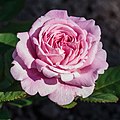Rosa abyssinica: Difference between revisions
Added use Tags: Visual edit Mobile edit Mobile web edit |
Added NIH study Tags: Visual edit Mobile edit Mobile web edit |
||
| Line 25: | Line 25: | ||
''Rosa abyssinica'' has been cultivated traditionally as a "living fence” surrounding home gardens in rural Ethiopian villages. <ref>{{Cite web|url=https://www.bioversityinternational.org/fileadmin/_migrated/uploads/tx_news/Home_gardens_and_in_situ_conservation_of_plant_genetic_resources_in_farming_systems_753.pdf|title=Home gardens and in situ conservation of plant genetic resources in farming systems|last=J.W. Watson and P.B. Eyzaguirre, editors|first=|date=17–19 July 2001|website=Biodiversity International|archive-url=|archive-date=|dead-url=|access-date=}}</ref> |
''Rosa abyssinica'' has been cultivated traditionally as a "living fence” surrounding home gardens in rural Ethiopian villages. <ref>{{Cite web|url=https://www.bioversityinternational.org/fileadmin/_migrated/uploads/tx_news/Home_gardens_and_in_situ_conservation_of_plant_genetic_resources_in_farming_systems_753.pdf|title=Home gardens and in situ conservation of plant genetic resources in farming systems|last=J.W. Watson and P.B. Eyzaguirre, editors|first=|date=17–19 July 2001|website=Biodiversity International|archive-url=|archive-date=|dead-url=|access-date=}}</ref> |
||
Indigenous communities use edible parts (fruits) of ''Rosa abyssinica'' to alleviate weakness, dizziness or tension.<ref>{{Cite journal|last=Chekole|first=Getnet|last2=Asfaw|first2=Zemede|last3=Kelbessa|first3=Ensermu|date=2015-01-07|title=Ethnobotanical study of medicinal plants in the environs of Tara-gedam and Amba remnant forests of Libo Kemkem District, northwest Ethiopia|url=https://www.ncbi.nlm.nih.gov/pmc/articles/PMC4417315/|journal=Journal of Ethnobiology and Ethnomedicine|volume=11|doi=10.1186/1746-4269-11-4|issn=1746-4269|pmc=4417315|pmid=25572933}}</ref> |
|||
<br /> |
<br /> |
||
Revision as of 06:56, 15 August 2019
| Rosa abyssinica | |
|---|---|

| |
| Scientific classification | |
| Kingdom: | Plantae |
| Clade: | Tracheophytes |
| Clade: | Angiosperms |
| Clade: | Eudicots |
| Clade: | Rosids |
| Order: | Rosales |
| Family: | Rosaceae |
| Genus: | Rosa |
| Species: | R. abyssinica
|
| Binomial name | |
| Rosa abyssinica | |
| Synonyms | |
|
Rosa abyssinica var. microphylla Crép. | |
Rosa abyssinica[1] is a plant species described by Robert Brown.[2] Rosa abyssinica is included in the genus Rosa, and the family Rosaceae.[3] No subspecies are listed in the Catalogue of Life.[3]
Description
Rosa abyssinica is a prickly evergreen shrub, creeping or often climbing, sometimes forming a small tree between 0.5 meters and 7 meters tall. It has a few prickles on the stem, slightly curved from a wide base and all similar. It has many variable features. The leaves are compound and leathery. It has 3 pairs leaflets plus one at the tip, each narrowly ovate from 1 cm to 6 cm, tip sharp, edge toothed, on a short stalk which is winged by the leafy stipules. Flowers are of fragrant white-pale yellow, and are usually 3 to 20 in dense heads, each stalked, the sepals long, narrow and hairy, soon fall, and have 5 petals about 2 cm long, tip rounded to square, with many stamens. The fruits are green at first, but later ripen to orange-red. They are about 2 cm long, fleshy and edible with seed within.[4]
Geographical distribution
Rosa abyssinica can be found only in Arabia, Ethiopia, Yemen, Somalia and the Sudan. This rose is common in the mid-lands and highlands. It commonly forms thickets in upland dry evergreen forests, margins, clearings, upland bushland, rocky places, dry grassland and riparian formations. It is also found in different types of man-made habitats, sometimes standing alone as a small tree between 0.5 and 7 meters tall.[4]
Uses
Rosa abyssinica has been cultivated traditionally as a "living fence” surrounding home gardens in rural Ethiopian villages. [5]
Indigenous communities use edible parts (fruits) of Rosa abyssinica to alleviate weakness, dizziness or tension.[6]
References
- ^ R.Br., 1814 In: Salt, Voy. Abyss. App. 64
- ^ Brown, Robert (1866). The Miscellaneous Botanical Works of Robert Brown, Volume 1. London England: Robert Hardwicke.
- ^ a b Roskov Y.; Kunze T.; Orrell T.; Abucay L.; Paglinawan L.; Culham A.; Bailly N.; Kirk P.; Bourgoin T.; Baillargeon G.; Decock W.; De Wever A. (2014). Didžiulis V. (ed.). "Species 2000 & ITIS Catalogue of Life: 2014 Annual Checklist". Species 2000: Reading, UK.
- ^ a b Hedberg, I.; Edwards, S (2014). "Category 3: 'Wild Food Plants Attracting Additional Consumer Categories". Ethiopia: Famine Food Field Guide.
{{cite web}}: Unknown parameter|last-author-amp=ignored (|name-list-style=suggested) (help) - ^ J.W. Watson and P.B. Eyzaguirre, editors (17–19 July 2001). "Home gardens and in situ conservation of plant genetic resources in farming systems" (PDF). Biodiversity International.
{{cite web}}:|last=has generic name (help); Cite has empty unknown parameter:|dead-url=(help) - ^ Chekole, Getnet; Asfaw, Zemede; Kelbessa, Ensermu (2015-01-07). "Ethnobotanical study of medicinal plants in the environs of Tara-gedam and Amba remnant forests of Libo Kemkem District, northwest Ethiopia". Journal of Ethnobiology and Ethnomedicine. 11. doi:10.1186/1746-4269-11-4. ISSN 1746-4269. PMC 4417315. PMID 25572933.
{{cite journal}}: CS1 maint: unflagged free DOI (link)

